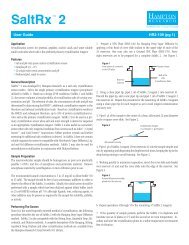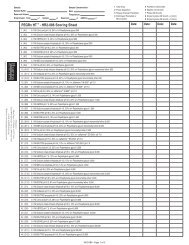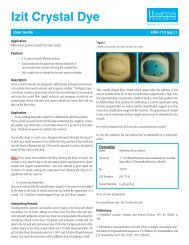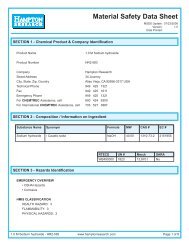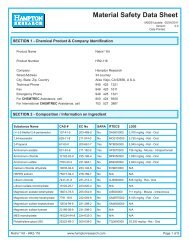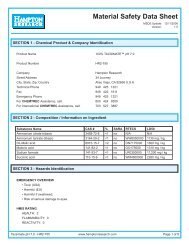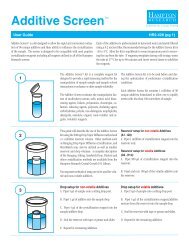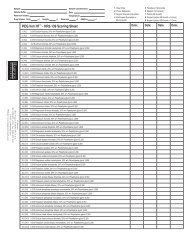PEGRx HT Fundamentals HR2-086 (pg 1) - Hampton Research
PEGRx HT Fundamentals HR2-086 (pg 1) - Hampton Research
PEGRx HT Fundamentals HR2-086 (pg 1) - Hampton Research
Create successful ePaper yourself
Turn your PDF publications into a flip-book with our unique Google optimized e-Paper software.
<strong>PEGRx</strong>TMSolutions for Crystal Growth<strong>PEGRx</strong> <strong>HT</strong> <strong>Fundamentals</strong> <strong>HR2</strong>-<strong>086</strong> (<strong>pg</strong> 1)How to Reproduce <strong>PEGRx</strong> <strong>HT</strong> Reagents<strong>PEGRx</strong> <strong>HT</strong> reagents and optimization conditions based on <strong>PEGRx</strong> <strong>HT</strong> hitscan be formulated using volumetric methods and carefully prepared reagentstocks (Table 1). Note the examples below.Example 1. To prepare 1.0 milliliter of <strong>PEGRx</strong> 1 reagent 14 (Well B2).Solution Composition: 0.1 M MES monohydrate pH 6.020% v/v Jeffamine ® M-600 ® pH 7.0• 500 ml water 3• 100 ml 1.0 M MES monohydrate pH 6.0(CAS # 145224-94-8, Catalog # <strong>HR2</strong>-943-09)• 400 ml 50% v/v Jeffamine ® M-600 ® pH 7.0(CAS # 77110-54-4, Catalog # <strong>HR2</strong>-501)Make no pH adjustments. Mix well.Example 2. To prepare 1.0 milliliter of <strong>PEGRx</strong> 2 reagent 15 (Well F3).Solution Composition: 0.1 M Sodium malonate pH 8.00.1 M Tris pH 8.030% w/v Polyethylene glycol 1,000• 570.6 ml water 3• 29.4 ml 3.4 M Sodium malonate pH 8.0(CAS # 141-82-2, Catalog # <strong>HR2</strong>-807)• 100 ml 1.0 M Tris pH 8.0(CAS # 77-86-1, Catalog # <strong>HR2</strong>-900-11)• 300 ml 100% w/v Polyethylene glycol 1,000(CAS # 25322-68-3, Catalog # <strong>HR2</strong>-523)Make no pH adjustments. Mix well.Example 3. To prepare 1 milliliter of <strong>PEGRx</strong> 2 reagent 48 (Well H12).Solution Composition: 3% w/v Dextran sulfate sodium salt0.1 M BICINE pH 8.515% w/v Polyethylene glycol 20,000• 300 ml water 3• 100 ml 1.0 M BICINE pH 8.5(CAS # 150-25-4, Catalog # <strong>HR2</strong>-999-10)• 100 ml 30% w/v Dextran sulfate sodium salt(CAS # 9011-18-1, Catalog # <strong>HR2</strong>-428-51)• 500 ml 30% w/v Polyethylene glycol 20,000(CAS # 25322-68-3, Catalog # <strong>HR2</strong>-609)Make no pH adjustments. Mix well.3ASTM Type I water.Formulation Notes for <strong>PEGRx</strong> <strong>HT</strong> Reagents1. No additional pH adjustment is made to any reagent after formulation.Use the salts and buffers in Table 1 to reproduce a <strong>PEGRx</strong> <strong>HT</strong> reagent.2. All Optimize solutions and screen reagents are sterile filtered using 0.22mm filters into sterile containers.3. Add water first as this will help maintain the solubility of subsequentlyadded reagents.4. When formulating reagents using a pipet, add the largest volumelast (except water). Use this larger volume setting to aspirate anddispense the reagent until the solution is mixed.5. When formulating reagents using a pipet, use a clean, sterile pipet tipfor each reagent added to the solution.6. Use Optimize , Custom Shop , StockOptions pH, and StockOptions pH buffer kits from <strong>Hampton</strong> <strong>Research</strong> to systematically vary the pH asa crystallization variable.7. The measured final pH of all <strong>PEGRx</strong> <strong>HT</strong> reagents is available atwww.hamptonresearch.com. Search using catalog number <strong>HR2</strong>-<strong>086</strong>and follow the link to the ‘<strong>PEGRx</strong> <strong>HT</strong> pH and Conductivity’ document.pH as a Crystallization VariableThe buffers listed in Table 2 can be used to vary the pH as a crystallizationvariable and are recommended when optimizing a crystal grown from a<strong>PEGRx</strong> <strong>HT</strong> kit.Optimize buffer stocks are supplied as a 100 milliliters sterile filtered solution.StockOptions buffer kits contain 10 milliliters each of ready to pipet buffers,titrated in 0.1 pH increments over the indicated pH range. The number ofreagents offered in a StockOptions buffer kit depends upon the pH range ofthe buffer. The broader the pH range, the more buffers in the kit.Custom Shop ready to pipet buffers are made to order, pH titrated bufferstocks from <strong>Hampton</strong> <strong>Research</strong>.
<strong>PEGRx</strong>TMSolutions for Crystal Growth<strong>PEGRx</strong> <strong>HT</strong> <strong>Fundamentals</strong> <strong>HR2</strong>-<strong>086</strong> (<strong>pg</strong> 2)Online InformationVisit www.hamptonresearch.com and enter one of the following:• Reagent Catalog Number• Kit Catalog Number• CAS Number• Reagent NameTo obtain reagent specifications, pH titration tables, user guides, certificatesof analysis, material safety data sheets (MSDS), and any other additionalinformation.MakeTrayMakeTray is a free, web based program at www.hamptonresearch.comwhich generates both a pipetting worksheet and a reagent formulationdocument for crystallization set ups. MakeTray allows one to entergeneral information about the sample and experiment, which is thenprinted on the pipet worksheet and the reagent formulation document.The plate size can be customized for any number of wells, so MakeTrayworks for: 24, 48, and 96 well plates. MakeTray is especially usefulfor the design and formulation of crystal optimization experiments.Table 1. Recommended reagents for the formulation of <strong>PEGRx</strong> <strong>HT</strong> and optimization reagents.Each of these reagents are available as an Optimize crystallizationgrade reagent from <strong>Hampton</strong> <strong>Research</strong>. Table 1 provides the commonchemical name, the <strong>Hampton</strong> <strong>Research</strong> catalog number, supplied stockconcentration, the supplied volume, and the CAS number for eachreagent. For more information on a specific Optimize reagent, go toAdditive<strong>Hampton</strong> <strong>Research</strong>Catalog #www.hamptonresearch.com. Using Search, enter either the catalognumber, CAS number, or chemical name to obtain additional informationfor the Optimize reagent, including a Certificate of Analysis and MSDS(where applicable).Supplied[ Stock ]SuppliedVolumeCAS #CYMAL ® -7 <strong>HR2</strong>-406-23 1.9 mM 0.5 ml 349477-49-2Dextran sulfate sodium salt <strong>HR2</strong>-428-51 30% w/v 1.0 ml 9011-18-1n-Octyl-b-D-glucoside <strong>HR2</strong>-428-71 5% w/v 1.0 ml 29836-26-8Organics (Volatile)<strong>Hampton</strong> <strong>Research</strong>Catalog #Supplied[ Stock ]SuppliedVolume1,4-Dioxane <strong>HR2</strong>-617 100% 200 ml 123-91-12-Propanol <strong>HR2</strong>-619 100% 200 ml 67-63-0CAS #Polyol<strong>Hampton</strong> <strong>Research</strong>Catalog #Supplied[ Stock ]SuppliedVolumeCAS #(+/-)-2-Methyl-2,4-pentanediol <strong>HR2</strong>-627 100% 200 ml 107-41-5Ethylene glycol <strong>HR2</strong>-621 100% 100 ml 107-21-1Polyethylene glycol 200 <strong>HR2</strong>-601 100% 200 ml 25322-68-3Polyethylene glycol 400 <strong>HR2</strong>-603 100% 200 ml 25322-68-3Ammonium acetateSalt<strong>Hampton</strong> <strong>Research</strong>Catalog #Supplied[ Stock ]SuppliedVolumeCAS #<strong>HR2</strong>-565 1.0 M 100 ml 631-61-8<strong>HR2</strong>-799 8.0 M 200 ml 631-61-8(Salt Continued on page 3)
<strong>PEGRx</strong>TMSolutions for Crystal Growth<strong>PEGRx</strong> <strong>HT</strong> <strong>Fundamentals</strong> <strong>HR2</strong>-<strong>086</strong> (<strong>pg</strong> 3)Table 1 (Continued).Recommended reagents for the formulation of <strong>PEGRx</strong> <strong>HT</strong> and optimization reagents.Salt<strong>Hampton</strong> <strong>Research</strong>Catalog #Supplied[ Stock ]SuppliedVolumeCAS #Ammonium citrate tribasic pH 7.0 <strong>HR2</strong>-759 2.5 M 200 ml 3458-72-8Ammonium sulfate <strong>HR2</strong>-541 3.5 M 200 ml 7783-20-2Cadmium chloride hydrate <strong>HR2</strong>-715 1.0 M 100 ml 654054-66-7Calcium chloride dihydrate <strong>HR2</strong>-557 2.0 M 100 ml 10035-04-8L-Proline <strong>HR2</strong>-775 1.0 M 100 ml 147-85-3Lithium sulfate monohydrate <strong>HR2</strong>-545 2.0 M 200 ml 10102-25-7Magnesium chloride hexahydrate<strong>HR2</strong>-559 2.0 M 100 ml 7791-18-6<strong>HR2</strong>-803 5.0 M 200 ml 7791-18-6Magnesium formate dihydrate <strong>HR2</strong>-537 1.0 M 200 ml 557-39-1DL-Malic acid pH 7.0 <strong>HR2</strong>-761 3.0 M 200 ml 6915-15-7Nickel(II) chloride hexahydrate <strong>HR2</strong>-687 4.0 M 200 ml 7791-20-0Potassium formate <strong>HR2</strong>-667 14.0 M 200 ml 590-29-4Potassium sodium tartrate tetrahydrate <strong>HR2</strong>-539 1.5 M 200 ml 6381-59-5Succinic acid pH 7.0 <strong>HR2</strong>-709 1.2 M 200 ml 110-15-6Sodium chloride <strong>HR2</strong>-637 5.0 M 200 ml 7647-14-5Sodium formate <strong>HR2</strong>-547 7.0 M 200 ml 141-53-7Sodium malonate pH 5.0 <strong>HR2</strong>-749 3.4 M 200 ml 141-82-2Sodium malonate pH 6.0 <strong>HR2</strong>-751 3.4 M 200 ml 141-82-2Sodium malonate pH 8.0 <strong>HR2</strong>-807 3.4 M 200 ml 141-82-2Tacsimate pH 4.0 <strong>HR2</strong>-823 100% 200 ml N/ATacsimate pH 6.0 <strong>HR2</strong>-827 100% 200 ml N/ATacsimate pH 7.0 <strong>HR2</strong>-755 100% 200 ml N/APolymer<strong>Hampton</strong> <strong>Research</strong>Catalog #Supplied[ Stock ]SuppliedVolumeCAS #Jeffamine ® ED-2001 pH 7.0 <strong>HR2</strong>-597 50% w/v 200 ml 65605-36-9Jeffamine ® M-600 ® pH 7.0 <strong>HR2</strong>-501 50% v/v 200 ml 77110-54-4Polyethylene glycol 200 <strong>HR2</strong>-601 100% 200 ml 25322-68-3Polyethylene glycol 300 <strong>HR2</strong>-517 100% 200 ml 25322-68-3Polyethylene glycol 400 <strong>HR2</strong>-603 100% 200 ml 25322-68-3Polyethylene glycol 1,000 <strong>HR2</strong>-523 50% w/v 200 ml 25322-68-3Polyethylene glycol 1,500 <strong>HR2</strong>-525 50% w/v 200 ml 25322-68-3(Polymer Continued on page 4)
<strong>PEGRx</strong>TMSolutions for Crystal Growth<strong>PEGRx</strong> <strong>HT</strong> <strong>Fundamentals</strong> <strong>HR2</strong>-<strong>086</strong> (<strong>pg</strong> 4)Table 1 (Continued).Recommended reagents for the formulation of <strong>PEGRx</strong> <strong>HT</strong> and optimization reagents.Polymer<strong>Hampton</strong> <strong>Research</strong>Catalog #Supplied[ Stock ]SuppliedVolumeCAS #Polyethylene glycol 3,350 <strong>HR2</strong>-527 50% w/v 200 ml 25322-68-3Polyethylene glycol 4,000 <strong>HR2</strong>-529 50% w/v 200 ml 25322-68-3Polyethylene glycol 6,000 <strong>HR2</strong>-533 50% w/v 200 ml 25322-68-3Polyethylene glycol 8,000 <strong>HR2</strong>-535 50% w/v 200 ml 25322-68-3Polyethylene glycol 10,000 <strong>HR2</strong>-607 50% w/v 200 ml 25322-68-3Polyethylene glycol 20,000 <strong>HR2</strong>-609 30% w/v 200 ml 25322-68-3Polyethylene glycol monomethyl ether 550 <strong>HR2</strong>-611 100% 200 ml 9004-74-4Polyethylene glycol monomethyl ether 2,000 <strong>HR2</strong>-613 50% w/v 200 ml 9004-74-4Polyethylene glycol monomethyl ether 5,000 <strong>HR2</strong>-615 50% w/v 200 ml 9004-74-4Buffer<strong>Hampton</strong> <strong>Research</strong>Catalog #Supplied[ Stock ]SuppliedVolumeCAS #BICINE pH 8.5 2 <strong>HR2</strong>-999-10 1.0 M 185 ml 150-25-4BIS-TRIS pH 6.5 1 <strong>HR2</strong>-783 1.0 M 100 ml 6976-37-0BIS-TRIS propane pH 9.0 1 <strong>HR2</strong>-993-28 1.0 M 185 ml 64431-96-5Citric acid pH 3.5 2 <strong>HR2</strong>-757 1.0 M 100 ml 77-92-9HEPES pH 7.5 2 <strong>HR2</strong>-729 1.0 M 100 ml 7365-45-9Imidazole pH 7.0 1 <strong>HR2</strong>-819 1.0 M 100 ml 288-32-4MES monohydrate pH 6.0 2 <strong>HR2</strong>-943-09 1.0 M 185 ml 145224-94-8Sodium acetate trihydrate pH 4.0 1 <strong>HR2</strong>-933-05 1.0 M 185 ml 6131-90-4Sodium acetate trihydrate pH 4.5 1 <strong>HR2</strong>-789 1.0 M 100 ml 6131-90-4Sodium citrate tribasic dihydrate pH 5.0 1 <strong>HR2</strong>-935-09 1.0 M 185 ml 6132-04-3Sodium citrate tribasic dihydrate pH 5.5 1 <strong>HR2</strong>-935-14 1.0 M 185 ml 6132-04-3Tris pH 8.0 1 <strong>HR2</strong>-900-11 1.0 M 185 ml 77-86-11pH titrated using Hydrochloric acid (<strong>HR2</strong>-581) CAS # 7647-01-02pH titrated using Sodium hydroxide (<strong>HR2</strong>-583) CAS # 1310-73-2
<strong>PEGRx</strong>TMSolutions for Crystal Growth<strong>PEGRx</strong> <strong>HT</strong> <strong>Fundamentals</strong> <strong>HR2</strong>-<strong>086</strong> (<strong>pg</strong> 5)Table 2. Recommended buffers for screening the pH of <strong>PEGRx</strong> <strong>HT</strong> and optimization reagents.Buffer Solution or Kit<strong>Hampton</strong> <strong>Research</strong>Catalog #Supplied[ Stock ]SuppliedVolumeCAS #StockOptions BICINE <strong>HR2</strong>-999-** 1.0 M 185 ml 150-25-4 7.6 - 9.0StockOptions Bis-Tris kit 4 <strong>HR2</strong>-106 1.0 M 10 ml each 6976-37-0 5.5 - 7.5StockOptions Bis-Tris propane <strong>HR2</strong>-993-** 1.0 M 185 ml 64431-96-5 6.3 - 9.5StockOptions Citric acid 4 <strong>HR2</strong>-104 1.0 M 10 ml each 77-92-9 2.2 - 6.5StockOptions Hepes kit 4 <strong>HR2</strong>-102 1.0 M 10 ml each 7365-45-9 6.8 - 8.2StockOptions Imidazole <strong>HR2</strong>-995-** 1.0 M 185 ml 288-32-4 6.2 - 7.8StockOptions MES kit 4 <strong>HR2</strong>-243 1.0 M 10 ml each 145224-94-8 5.2 - 7.1StockOptions Sodium Acetate kit 4 <strong>HR2</strong>-233 1.0 M 10 ml each 6131-90-4 3.6 - 5.6StockOptions Sodium Citrate kit 4 <strong>HR2</strong>-235 1.0 M 10 ml each 6132-04-3 4.2 - 6.5StockOptions Tris 4 <strong>HR2</strong>-100 1.0 M 10 ml each 77-86-1 7.0 - 9.0pH range4Individual StockOptions buffers titrated to any pH within the kit’s pH range are available in 185 ml volumes from the <strong>Hampton</strong> <strong>Research</strong> Custom Shop ** Refers to the reagent number in the kit. For example, reagent number 1 = <strong>HR2</strong>-993-01 (pH 6.3)Technical SupportInquiries regarding <strong>PEGRx</strong> <strong>HT</strong> <strong>Fundamentals</strong>, interpretation of screen results,optimization strategies and general inquiries regarding crystallizationare welcome. Please e-mail, fax, or telephone your request to <strong>Hampton</strong> <strong>Research</strong>.Fax and e-mail Technical Support are available 24 hours a day.Telephone technical support is available 8:00 a.m. to 5:00 p.m. USA PacificStandard Time.



